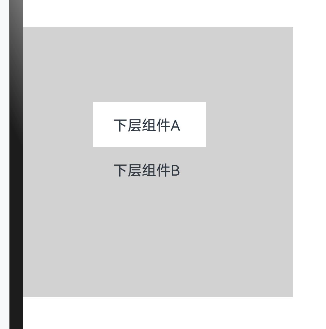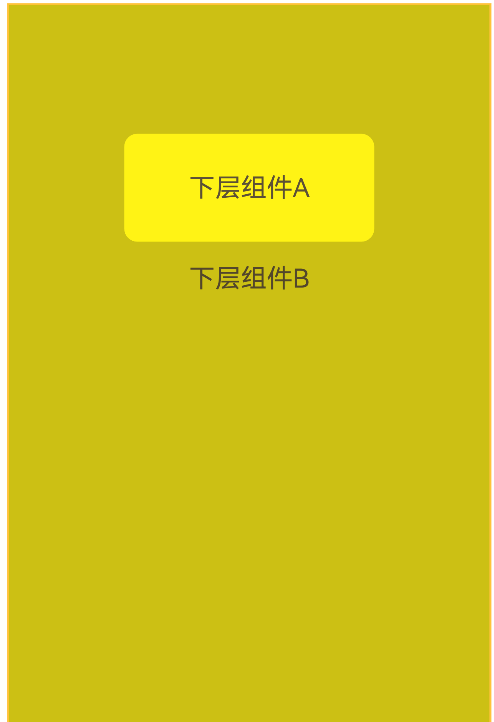HarmonyOS鸿蒙Next中遮罩中开一个孔能点击下层组件怎么实现?
HarmonyOS鸿蒙Next中遮罩中开一个孔能点击下层组件怎么实现? 之前可能描述不够清楚,修改了一下。
下面测试代码,灰色遮罩遮住一部分下层组件,屏蔽下层点击,镂空区域需要允许点击下层。
最好是通用的,因为遮罩和下层的东西(其他人的模块)是改不了先后顺序和组件内容的
@Entry
@Component
struct Canvas02 {
build() {
Column() {
Text('下层组件A').position({ x: 100, y: 100 }).onClick(() => console.log('下层组件A'))
Text('下层组件B').position({ x: 100, y: 150 }).onClick(() => console.log('下层组件B'))
Column().backgroundColor('#39373737').size({ width: 300, height: 300 }).onClick(() => console.log('遮罩组件'))
}
}
}
下图右边是镂空目标效果(改为圆角矩形),
点击下层组件B,要输出遮罩组件日志,
点击下层组件A,要输下层组件A日志

更多关于HarmonyOS鸿蒙Next中遮罩中开一个孔能点击下层组件怎么实现?的实战教程也可以访问 https://www.itying.com/category-93-b0.html
使用 HitTestMode.Transparent 让 Canvas 的事件传递到底层。
@Entry
@Component
struct Index {
@State offsetY: number = 100
private contextSettings: RenderingContextSettings = new RenderingContextSettings(true);
private ctx: CanvasRenderingContext2D = new CanvasRenderingContext2D(this.contextSettings);
private rect: Rectangle = {}
build() {
Stack() {
Text('下层组件B')
.fontSize(20)
.fontColor('#333')
.offset({ y: 200 })
Text('下层组件A')
.fontSize(20)
.fontColor('#333')
.padding({
left: 50,
right: 50,
top: 30,
bottom: 30
})
.offset({ y: this.offsetY })
.onAreaChange((oldValue: Area, newValue: Area) => {
const x = newValue.position.x
const y = newValue.position.y
const width = newValue.width
const height = newValue.height
this.rect = {
x,
y,
width,
height
}
this.draw()
})
.onClick(() => {
this.offsetY += 10
this.draw()
console.log('下层组件-点击了 this.offsetY = ' + this.offsetY)
})
Canvas(this.ctx)
.width('100%')
.height('100%')
.backgroundColor(Color.Transparent)
.hitTestBehavior(HitTestMode.Transparent)
.onReady(() => {
})
}
.align(Alignment.Top)
.width('100%')
.height('100%')
.backgroundColor('#ff0')
}
draw() {
const x = this.rect.x as number
const y = this.rect.y as number + this.offsetY
const width = this.rect.width as number
const height = this.rect.height as number
const radius = 10
this.ctx.reset()
// 遮罩层
this.ctx.fillStyle = '#40000000';
this.ctx.beginPath();
this.ctx.moveTo(0, 0);
this.ctx.lineTo(0, this.ctx.height);
this.ctx.lineTo(this.ctx.width, this.ctx.height);
this.ctx.lineTo(this.ctx.width, 0);
this.ctx.lineTo(0, 0);
// 圆角矩形 API20 可用 roundRect
this.ctx.arc(x + radius, y + radius, radius, Math.PI, Math.PI * 3 / 2);
this.ctx.lineTo(width - radius + x, y);
this.ctx.arc(width - radius + x, radius + y, radius, Math.PI * 3 / 2, Math.PI * 2);
this.ctx.lineTo(width + x, height + y - radius);
this.ctx.arc(width - radius + x, height - radius + y, radius, 0, Math.PI / 2);
this.ctx.lineTo(radius + x, height + y);
this.ctx.arc(radius + x, height - radius + y, radius, Math.PI / 2, Math.PI);
this.ctx.lineTo(x, y + radius);
this.ctx.fill();
this.ctx.closePath();
}
}

点击下层组件B,要输出遮罩组件日志,
点击下层组件A,要输下层组件A日志 现在你这个代码点击遮罩层如果输出日志,A日志好像触发不了,
把Colunm与Text创建顺序调整一下就行,后创建的组件会覆盖先创建的组件。
Column().backgroundColor('#39373737').size({ width: 300, height: 300 })
Text('下层组件').position({ x: 100, y: 100 }).onClick(() => console.log('点击下层'))
.width(100).height(100).backgroundColor("#fff")
如果不想改顺序在Text组件后面加上zIndex(vaule:number)也是可以解决的,当元素重叠时,具有较高z-index值的元素将显示在具有较低z-index值的元素之上
Text('下层组件').position({ x: 100, y: 100 }).onClick(() => console.log('点击下层'))
.width(100).height(100).backgroundColor("#fff").zIndex(999)
Column().backgroundColor('#39373737').size({ width: 300, height: 300 })
通常遇到组件重叠()、层级控制可以用stack,这样你就不需要Position来定位到Column上面了
Stack() {
Column()
.backgroundColor('#39373737')
.size({ width: 300, height: 300 })
Text('上层组件')
.width(100)
.height(100)
.backgroundColor("#fff")
}
参考链接:Stack-行列与堆叠-ArkTS组件-ArkUI(方舟UI框架)-应用框架 - 华为HarmonyOS开发者
我之前可能没有描述清楚,编辑了问题,镂空区穿透,以外的区域不穿透,怎么实现啊?
@Entry
@Component
struct Canvas02 {
build() {
Stack({ alignContent: Alignment.TopStart }) {
// 底层遮罩组件
Column()
.backgroundColor('#39373737')
.size({ width: 300, height: 300 })
.onClick(() => console.log('遮罩组件'))
.hitTestBehavior(HitTestMode.Transparent) // 允许事件穿透
// 上层交互组件
Column() {
Text('下层组件A')
.position({ x: 100, y: 100 })
.onClick(() => console.log('下层组件A'))
Text('下层组件B')
.position({ x: 100, y: 150 })
.hitTestBehavior(HitTestMode.None) // 禁用事件拦截
}
}
}
}
使用.hitTestBehavior(HitTestMode.Transparent)允许穿透,.hitTestBehavior(HitTestMode.None)禁止穿透
您好使用触摸测试可以实现,望采纳!
@Entry
@Component
struct Index {
build() {
Stack() {
// 下层内容组件
Column() {
Text('底层内容区域').fontSize(20)
}
.width('100%')
.height('100%')
.backgroundColor(Color.White)
.onClick(() => {
this.getUIContext().getPromptAction().showToast({ message: '底层内容被点击' })
})
// 镂空遮罩层
Column() {
// 镂空区域(透明部分)
Column()
.width(200)
.aspectRatio(1)
.borderRadius('50%')
.backgroundColor(Color.White)
.position({ left: 20, top: 30 })
.hitTestBehavior(HitTestMode.Transparent) // 关键:允许点击穿透
.onClick(() => {
this.getUIContext().getPromptAction().showToast({ message: '透明部分' })
})
}
.width('100%')
.height('100%')
.backgroundColor('#80000000')
}
.width('100%')
.height('100%')
}
}
为啥要搞这么复杂,你直接用 Stack 容器不就好了。
直接让按钮在上层,遮罩在下层,
我之前可能没有描述清楚,编辑了问题,镂空区穿透,以外的区域不穿透,怎么实现啊?
设置点击事件的行为为穿透
我之前可能没有描述清楚,编辑了问题,镂空区穿透,以外的区域不穿透,怎么实现啊?
在HarmonyOS Next中,可通过@State和@Builder结合Stack组件实现遮罩开孔点击。使用Stack布局上层遮罩与下层内容,通过if条件控制遮罩层显示,在遮罩层使用Rect或Circle设置透明区域,并绑定onClick事件穿透至下层组件。示例代码片段:
@State isMaskVisible: boolean = true
build() {
Stack() {
// 下层组件
Button('点击我')
.onClick(() => {
// 处理点击
})
// 遮罩层
if (this.isMaskVisible) {
Rect()
.fill('#CC000000')
.clip(new Circle({ radius: 50 }))
.onClick(() => {
this.isMaskVisible = false
})
}
}
}
通过clip设置开孔形状,控制遮罩层显隐实现点击穿透。







